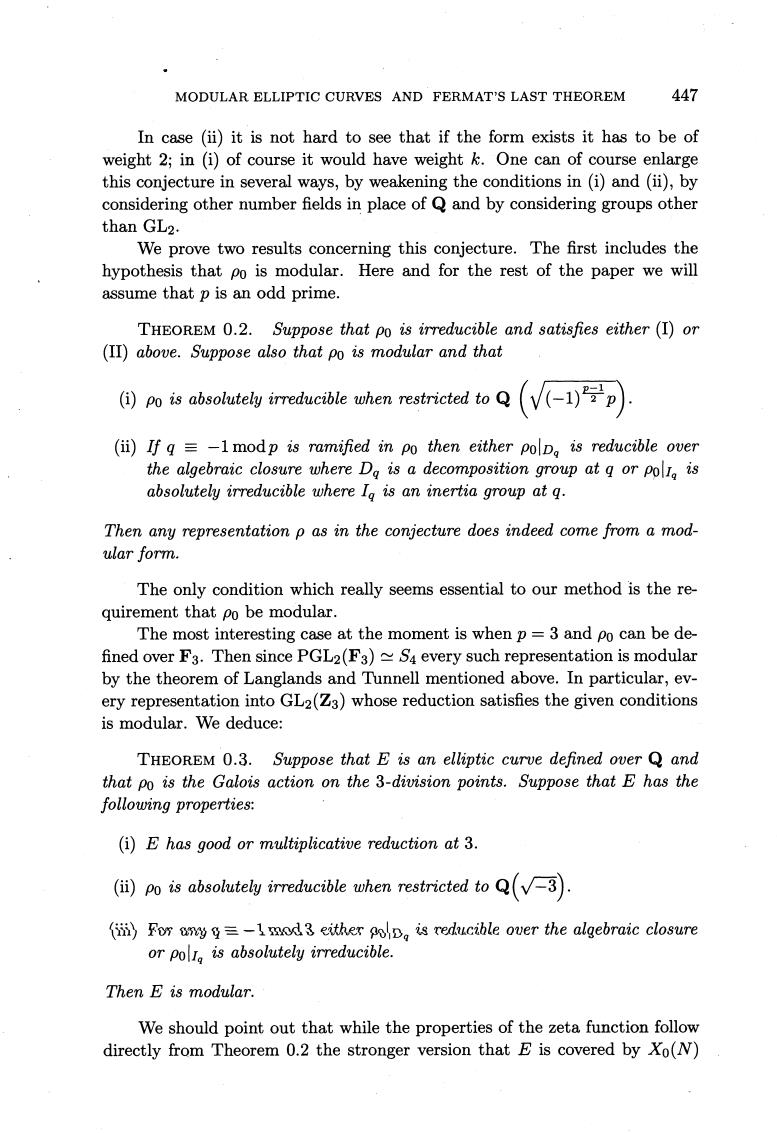正在加载图片...

MODULAR ELLIPTIC CURVES AND FERMAT'S LAST THEOREM 447 In case (ii)it is not hard to see that if the form exists it has to be of weight 2:in (i)of course it would have weight k.One can of course enlarge this conjecture in several ways,by weakening the conditions in(i)and (ii),by considering other number fields in place of Q and by considering groups other than GL2. We ove two results concerning this conjecture.The first includes the hypothesis that po is modular.Here and for the rest of the paper we will assume that p is an odd prime. THEOREM 0.2.Suppose that po is irreducible and satisfies either (I)or (II above.Suppose also that po is modular and that ))oisabseredube when restricted oQ(V-l)号p】 (ii)If q=-1modp is ramified in po then either polD is reducible over the algebraic closure where De is a decomposition group at g or po is absolutely irreducible where Ig is an inertia group atq Then any representation p as in the conjecture does indeed come from a mod ular form. The only condition which really seems essential to our method is the re- quirement that po be modular. The most interesting case at the moment is when p=3 and po can be de fined over F3.Then since PGL2(Fa)Severy such representation is modular by the theorem of Langlands and Tunnell mentioned above.In particular,ev- ery representation into GL2(Z3)whose reduction satisfies the given conditions is modular.We deduce: THEOREM 0.3.Suppose that E is an elliptic curve defined over Q and that po is the Galois action on the 3-division points.Suppose that E has the following properties: (i)E has good or multiplicative reduction at 3. (ii)po is absolutely irreducible when restricted to Q(3 For any=-1mod3either is reducible over the algebraic closure or po is absolutely irreducible. Then E is modular We should point out that while the properties of the zeta function follow directly from Theorem 0.2 the stronger version that E is covered by Xo(N)MODULAR ELLIPTIC CURVES AND FERMAT'S LAST THEOREM 447 In case (ii) it is not hard to see that if the form exists it has to be of weight 2; in [i) of course it would have weight k. One can of course enlarge this conjecture in several ways, by weakening the conditions in (i) and (ii), by considering other number fields in place of Q and by considering groups other than GL2. We prove two results concerning this conjecture. The first includes the hypothesis that po is modular. Here and for the rest of the paper we will assume that p is an odd prime. THEOREM 0.2. Suppose that po is irreducible and satisfies either (I) or (11) above. Suppose also that po is modular and that (i) po is absolutely irreducible when restricted to Q (J-a). (ii) If q q -1 modp is ramified in po then either polDq is reducible over the algebraic closure where Dq is a decomposition group at q or polIq is absolutely irreducible where Iq is an inertia group at q. Then any representation p as in the conjecture does indeed come from a modular form. The only condition which really seems essential to our method is the requirement that p~ be modular. The most interesting case at the moment is when p = 3 and po can be defined over F3. Then since PGL2(F3) E S4every such representation is modular by the theorem of Langlands and Tunnel1 mentioned above. In particular, every representation into GL2(Z3) whose reduction satisfies the given conditions is modular. We deduce: THEOREM 0.3. Suppose that E is an elliptic curve defined over Q and that po is the Galois action on the 3-division points. Suppose that E has the following properties: (i) E has good or multiplicative reduction at 3. (ii) po is absolutely irreducible when restricted to Q(-). tii"1) For awg q =- -lm~d3eithe~pQ(Dqis reducible over the algebraic closure or polIq is absolutely irreducible. Then E is modular. We should point out that while the properties of the zeta function follow directly from Theorem 0.2 the stronger version that E is covered by Xo(N)